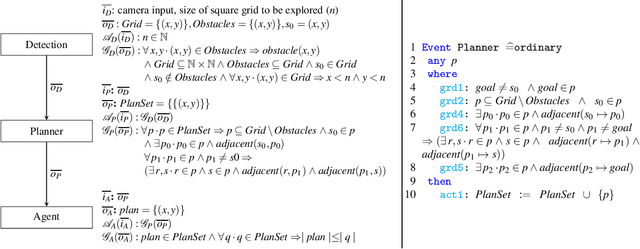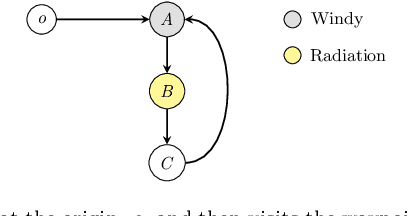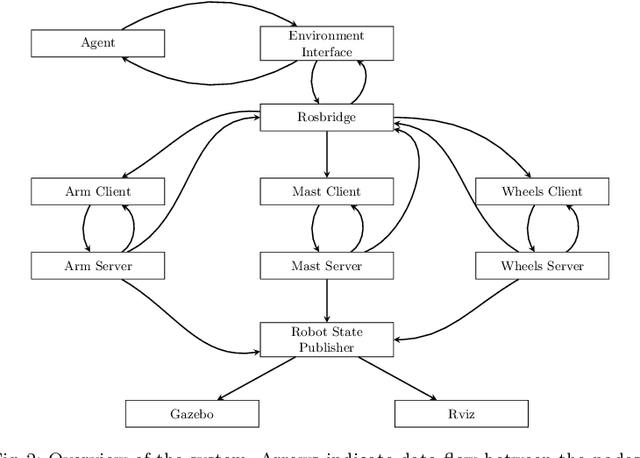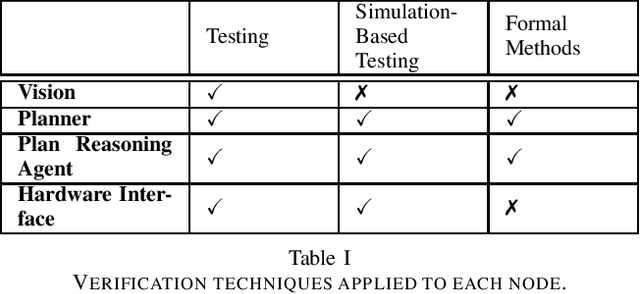Marie Farrell
University of Manchester, UK
Proceedings Fifth International Workshop on Formal Methods for Autonomous Systems
Nov 15, 2023Abstract:This EPTCS volume contains the proceedings for the Fifth International Workshop on Formal Methods for Autonomous Systems (FMAS 2023), which was held on the 15th and 16th of November 2023. FMAS 2023 was co-located with 18th International Conference on integrated Formal Methods (iFM) (iFM'22), organised by Leiden Institute of Advanced Computer Science of Leiden University. The workshop itself was held at Scheltema Leiden, a renovated 19th Century blanket factory alongside the canal. FMAS 2023 received 25 submissions. We received 11 regular papers, 3 experience reports, 6 research previews, and 5 vision papers. The researchers who submitted papers to FMAS 2023 were from institutions in: Australia, Canada, Colombia, France, Germany, Ireland, Italy, the Netherlands, Sweden, the United Kingdom, and the United States of America. Increasing our number of submissions for the third year in a row is an encouraging sign that FMAS has established itself as a reputable publication venue for research on the formal modelling and verification of autonomous systems. After each paper was reviewed by three members of our Programme Committee we accepted a total of 15 papers: 8 long papers and 7 short papers.
Proceedings Fourth International Workshop on Formal Methods for Autonomous Systems (FMAS) and Fourth International Workshop on Automated and verifiable Software sYstem DEvelopment (ASYDE)
Sep 27, 2022Abstract:This EPTCS volume contains the joint proceedings for the fourth international workshop on Formal Methods for Autonomous Systems (FMAS 2022) and the fourth international workshop on Automated and verifiable Software sYstem DEvelopment (ASYDE 2022), which were held on the 26th and 27th of September 2022. FMAS 2022 and ASYDE 2022 were held in conjunction with 20th International Conference on Software Engineering and Formal Methods (SEFM'22), at Humboldt University in Berlin. For FMAS, this year's workshop was our return to having in-person attendance after two editions of FMAS that were entirely online because of the restrictions necessitated by COVID-19. We were also keen to ensure that FMAS 2022 remained easily accessible to people who were unable to travel, so the workshop facilitated remote presentation and attendance. The goal of FMAS is to bring together leading researchers who are using formal methods to tackle the unique challenges presented by autonomous systems, to share their recent and ongoing work. Autonomous systems are highly complex and present unique challenges for the application of formal methods. Autonomous systems act without human intervention, and are often embedded in a robotic system, so that they can interact with the real world. As such, they exhibit the properties of safety-critical, cyber-physical, hybrid, and real-time systems. We are interested in work that uses formal methods to specify, model, or verify autonomous and/or robotic systems; in whole or in part. We are also interested in successful industrial applications and potential directions for this emerging application of formal methods.
Modelling the Turtle Python library in CSP
Jul 20, 2022



Abstract:Software verification is an important tool in establishing the reliability of critical systems. One potential area of application is in the field of robotics, as robots take on more tasks in both day-to-day areas and highly specialised domains. Robots are usually given a plan to follow, if there are errors in this plan the robot will not perform reliably. The capability to check plans for errors in advance could prevent this. Python is a popular programming language in the robotics domain, through the use of the Robot Operating System (ROS) and various other libraries. Python's Turtle package provides a mobile agent, which we formally model here using Communicating Sequential Processes (CSP). Our interactive toolchain CSP2Turtle with CSP model and Python components, enables Turtle plans to be verified in CSP before being executed in Python. This means that certain classes of errors can be avoided, and provides a starting point for more detailed verification of Turtle programs and more complex robotic systems. We illustrate our approach with examples of robot navigation and obstacle avoidance in a 2D grid-world.
* In Proceedings AREA 2022, arXiv:2207.09058
Proceedings Third Workshop on Formal Methods for Autonomous Systems
Oct 22, 2021Abstract:Autonomous systems are highly complex and present unique challenges for the application of formal methods. Autonomous systems act without human intervention, and are often embedded in a robotic system, so that they can interact with the real world. As such, they exhibit the properties of safety-critical, cyber-physical, hybrid, and real-time systems. This EPTCS volume contains the proceedings for the third workshop on Formal Methods for Autonomous Systems (FMAS 2021), which was held virtually on the 21st and 22nd of October 2021. Like the previous workshop, FMAS 2021 was an online, stand-alone event, as an adaptation to the ongoing COVID-19 restrictions. Despite the challenges this brought, we were determined to build on the success of the previous two FMAS workshops. The goal of FMAS is to bring together leading researchers who are tackling the unique challenges of autonomous systems using formal methods, to present recent and ongoing work. We are interested in the use of formal methods to specify, model, or verify autonomous and/or robotic systems; in whole or in part. We are also interested in successful industrial applications and potential future directions for this emerging application of formal methods.
Towards Compositional Verification for Modular Robotic Systems
Dec 03, 2020


Abstract:Software engineering of modular robotic systems is a challenging task, however, verifying that the developed components all behave as they should individually and as a whole presents its own unique set of challenges. In particular, distinct components in a modular robotic system often require different verification techniques to ensure that they behave as expected. Ensuring whole system consistency when individual components are verified using a variety of techniques and formalisms is difficult. This paper discusses how to use compositional verification to integrate the various verification techniques that are applied to modular robotic software, using a First-Order Logic (FOL) contract that captures each component's assumptions and guarantees. These contracts can then be used to guide the verification of the individual components, be it by testing or the use of a formal method. We provide an illustrative example of an autonomous robot used in remote inspection. We also discuss a way of defining confidence for the verification associated with each component.
* In Proceedings FMAS 2020, arXiv:2012.01176
Proceedings Second Workshop on Formal Methods for Autonomous Systems
Dec 02, 2020Abstract:Autonomous systems are highly complex and present unique challenges for the application of formal methods. Autonomous systems act without human intervention, and are often embedded in a robotic system, so that they can interact with the real world. As such, they exhibit the properties of safety-critical, cyber-physical, hybrid, and real-time systems. The goal of FMAS is to bring together leading researchers who are tackling the unique challenges of autonomous systems using formal methods, to present recent and ongoing work. We are interested in the use of formal methods to specify, model, or verify autonomous or robotic systems; in whole or in part. We are also interested in successful industrial applications and potential future directions for this emerging application of formal methods.
Heterogeneous Verification of an Autonomous Curiosity Rover
Jul 20, 2020

Abstract:The Curiosity rover is one of the most complex systems successfully deployed in a planetary exploration mission to date. It was sent by NASA to explore the surface of Mars and to identify potential signs of life. Even though it has limited autonomy on-board, most of its decisions are made by the ground control team. This hinders the speed at which the Curiosity reacts to its environment, due to the communication delays between Earth and Mars. Depending on the orbital position of both planets, it can take 4--24 minutes for a message to be transmitted between Earth and Mars. If the Curiosity were controlled autonomously, it would be able to perform its activities much faster and more flexibly. However, one of the major barriers to increased use of autonomy in such scenarios is the lack of assurances that the autonomous behaviour will work as expected. In this paper, we use a Robot Operating System (ROS) model of the Curiosity that is simulated in Gazebo and add an autonomous agent that is responsible for high-level decision-making. Then, we use a mixture of formal and non-formal techniques to verify the distinct system components (ROS nodes). This use of heterogeneous verification techniques is essential to provide guarantees about the nodes at different abstraction levels, and allows us to bring together relevant verification evidence to provide overall assurance.
Modular Verification of Autonomous Space Robotics
Aug 28, 2019

Abstract:Ensuring that autonomous space robot control software behaves as it should is crucial, particularly as software failure in space often equates to mission failure and could potentially endanger nearby astronauts and costly equipment. To minimise mission failure caused by software errors, we can utilise a variety of tools and techniques to verify that the software behaves as intended. In particular, distinct nodes in a robotic system often require different verification techniques to ensure that they behave as expected. This paper introduces a method for integrating the various verification techniques that are applied to robotic software, via a First-Order Logic (FOL) specification that captures each node's assumptions and guarantees. These FOL specifications are then used to guide the verification of the individual nodes, be it by testing or the use of a formal method. We also outline a way of measuring our confidence in the verification of the entire system in terms of the verification techniques used.
Robotics and Integrated Formal Methods: Necessity meets Opportunity
Sep 03, 2018Abstract:Robotic systems are multi-dimensional entities, combining both hardware and software, that are heavily dependent on, and influenced by, interactions with the real world. They can be variously categorised as embedded, cyberphysical, real-time, hybrid, adaptive and even autonomous systems, with a typical robotic system being likely to contain all of these aspects. The techniques for developing and verifying each of these system varieties are often quite distinct. This, together with the sheer complexity of robotic systems, leads us to argue that diverse formal techniques must be integrated in order to develop, verify, and provide certification evidence for, robotic systems. Furthermore, we propose the fast evolving field of robotics as an ideal catalyst for the advancement of integrated formal methods research, helping to drive the field in new and exciting directions and shedding light on the development of large-scale, dynamic, complex systems.
Formal Specification and Verification of Autonomous Robotic Systems: A Survey
Sep 03, 2018



Abstract:Robotic systems are complex and critical: they are inherently hybrid, combining both hardware and software; they typically exhibit both cyber-physical attributes and autonomous capabilities; and are required to be at least safe and often ethical. While for many engineered systems testing, either through real deployment or via simulation, is deemed sufficient the uniquely challenging elements of robotic systems, together with the crucial dependence on sophisticated software control and decision-making, requires a stronger form of verification. The increasing deployment of robotic systems in safety-critical scenarios exacerbates this still further and leads us towards the use of formal methods to ensure the correctness of, and provide sufficient evidence for the certification of, robotic systems. There have been many approaches that have used some variety of formal specification or formal verification in autonomous robotics, but there is no resource that collates this activity in to one place. This paper systematically surveys the state-of-the art in specification formalisms and tools for verifying robotic systems. Specifically, it describes the challenges arising from autonomy and software architectures, avoiding low-level hardware control and is subsequently identifies approaches for the specification and verification of robotic systems, while avoiding more general approaches.
 Add to Chrome
Add to Chrome Add to Firefox
Add to Firefox Add to Edge
Add to Edge